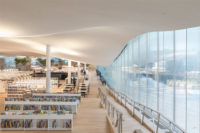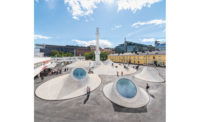On a January mid-morning in Helsinki—marked by a bracing cold, cerulean blue skies, and a pale-gold eastern light—Oodi, the city’s newly opened Central Library, gleams and glows from its seat in the cultural heart of the Finnish capital. A “people’s gift” to celebrate the centenary of independence for this most literate of nations, Oodi (which means “ode” in Finnish) is a monumental spruce-clad structure that lifts skyward with its luminescent glassy upper levels and, inside, hums with activity.
Additional Content:
Jump to credits & specifications
Designed by Helsinki-based ALA Architects, the public library forms the final framing element for the long-envisioned “Kansalaistori,” or Citizens’ Square, at the southern end of the city’s Töölö Bay. Oodi’s 325-foot-long form—rectilinear on three sides and twisted and torqued on its civic face—bounds the eastern edge of this cultural center, which includes Kiasma, the contemporary art museum (Steven Holl Architects, 1991); Sanoma House, the Helsinki news corporation’s headquarters (SARC, 1993); and the Helsinki Music Center (LPR Architects, 2011). The energy and symbolic character of the square are amplified by Eliel Saarinen’s adjacent Helsinki Railway Station (1915), as well as J.S. Siren’s nearby House of Parliament (1929), and Alvar Aalto’s Finlandia Hall (1974), with interiors by Elissa Aalto.
Approaching the commission, ALA sought to address the complex urban ensemble and the high ambitions of the existing architecture with characteristic directness. As principal Antti Nousjoki says, “The challenge was to take full advantage of every opportunity of this unbelievable situation—its urban presence, and possibilities for program experimentation, structural innovation, public engagement, and so on. We were determined to be positively, optimistically fearless.” ALA’s bold solution rises to this challenge and, in so doing, provides a contemporary library reenvisioned as an “urban living room” for the exchange of ideas and information and, with its ample studio spaces, as a public workshop to encourage creativity within the community.
Glass entries in the building’s dramatically double-curved wood-clad front facade—as well as those at the north and south corners—admit visitors into the column-free expanse of the ground level, which holds book-return counters, exhibition areas, a flexible performance space, a café and restaurant, a children’s area, and an auditorium. The horizontal expanse of this level is punctuated with an immense, double-helix-like concrete-and-steel stair that spirals up to makerspaces and meeting rooms on the middle level (called the “Attic” by the designers) and to the reading room, or “Book Heaven,” above that.
The middle “Attic” level reveals the robust structure enabling the open expanses above and below. Here, an innovative arching steel truss spans the building’s long axis, and is tied back into a reinforced-concrete tension slab. Imperceptible from the exterior, the complex construction dictates the Attic’s compressed interiors—lounges, workshops, rehearsal rooms, recording and production facilities, as well as corridors and fire stairs, which are all threaded in and around the structure. In contrast to the upper and lower levels, the inward-looking Attic has minimal daylighting, which is appropriate for the workspaces here, some of which require full enclosure and opacity for acoustic reasons.
Ascending from this floor to the top level “Book Heaven” has a restorative and uplifting effect. The ranks of books on bookshelves here communicate that the intimate acts of browsing and reading are still valued. The expansive, luminous reading room is illuminated and visually extended to the outdoors through floor-to-ceiling walls of fritted glass and a composition of skylights. Each of these apertures, which perforate the undulating white ceiling plane floating above, spotlights one of 10 potted whitewood trees, which will grow over time. The team designed the top floor as a contoured wooden terrain—a kind of “forest space"—whose oak flooring ramps and steps upward at the north and south ends, lifting dramatically to form plateaus, terraces, and overlooks.
For all its ambitions as a reading room, right now in the winter cold, the “Book Heaven” functions much as a community center, almost overwhelmingly active. The faceted wooden floor surfaces are alluring as a playground, and children gaily slide down their faces, while parents hover nearby. Animated conversations resonate from the central café on this level, and a constant parade of sightseers circumnavigates the space’s perimeter amidst the study tables and reading chairs. Still to come when good weather arrives is the opening of the west-facing terrace on this level, surely to become one of the city’s top viewing platforms.
The mission to reimagine the public library beyond its function as a repository for books was apparent in ALA’s 2014 competition entry as well as in the final programming of the building, which reflects intense input from the library staff and the public. The new role for the building type also is apparent in the library’s parallel redesign of staffing and services, which dictated an absence of administrative offices (now located in a suburban sister library) and the addition of improved technologies for book handling (checkouts, returns, and shelving). These moves will help maximize staff availability to the library user, a necessary strategy, given that the facility anticipates 10,000 visitors per day and 2.5 million annually. “It’s deeply rewarding to see the library in use now,” says Nousjoki. “There’s such a wide cross-section of Finnish society visible there—the complete spectrum of age, gender, income, and background—making full use of every floor and resource.”
The library’s efficiency in planning and operations can also be seen in its overall passive-energy design approach; the use of Finnish spruce and glass expanses for the facade is sensitive to local climate conditions and maximizes the admission of daylight. The design’s thermal performance and energy consumption have been calibrated through intensive BIM to a nearly Net Zero Energy Building level.
Combining the intimacy of a community library with the ambitions of a state-of-the-art center for contemporary culture, Oodi’s powerful architecture projects the institution as a place of civic importance and social engagement—one that prompts intellectual curiosity and creativity while reinforcing the country’s civic identity and aspirations.
CreditsArchitect: ALA Architects — Juho Grönholm, Antti Nousjoki, Janne Terävirta, Samuli Woolston, principals; Niklas Mahlberg, executive architect
Interior design: ALA Architects — Heikki Ruoho, interior architect
Engineers: Ramboll Finland (structural, HVAC, energy technology); Rejlers Finland (electrical); Sipti Infra (geo); Granlund (AV, theater technology)
General contractor: YIT Rakennus
|
SpecificationsWood cladding Timbeco, Timberpoint
Curtain wall, Windows Windoor
Skylights Warmeco, Klaasimeister
Doors Jaatimet, Jeld-Wen, Geze
Ceilings Rockfon
Wallcoverings Kvadrat
Flooring Pandomo Floor, Mero
Lighting Erco, Fagerhult, Wästberg, Led Linear, Cariitti, Regent, Planlicht, Gradus, Bega
Conveyance Otis |


















Post a comment to this article
Report Abusive Comment